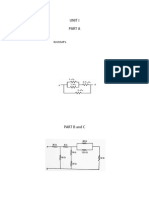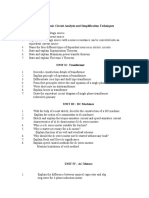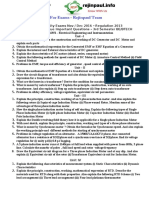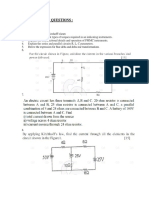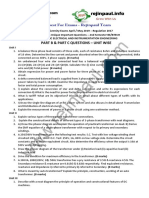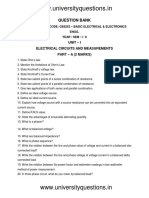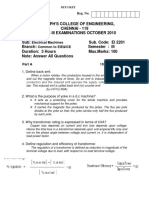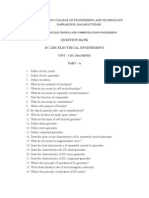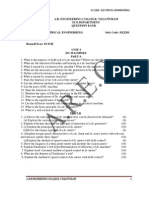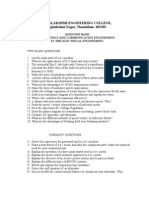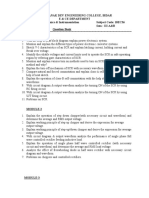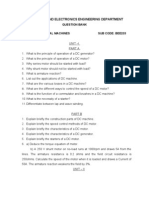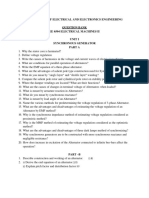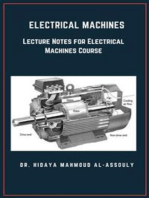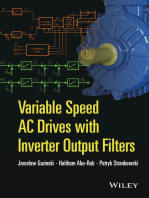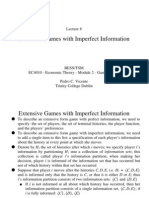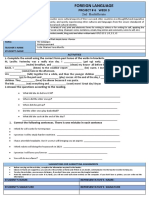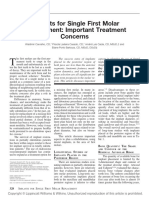DC MC& Meas Imp Questions
DC MC& Meas Imp Questions
Uploaded by
Divya prakash BillaCopyright:
Available Formats
DC MC& Meas Imp Questions
DC MC& Meas Imp Questions
Uploaded by
Divya prakash BillaOriginal Title
Copyright
Available Formats
Share this document
Did you find this document useful?
Is this content inappropriate?
Copyright:
Available Formats
DC MC& Meas Imp Questions
DC MC& Meas Imp Questions
Uploaded by
Divya prakash BillaCopyright:
Available Formats
UNIT-1: Basics of DC Generators
Shorts
1. List different types of DC generators.
2. What are the conditions for parallel operation of DC shunt generator?
3. State the functions of commutator, yoke and pole core in DC generator.
4. State Fleming’s left-hand rule?
5. List various losses in DC generator.
6. Define MNA and GNA.
7. A shunt generator delivers 500 A at 230 V and the resistance of the shunt field and armature are 50 W and 0.03 W respectively.
Calculate the generated emf.
8. Define the terms pole pitch, back pitch and front pitch in DC machine windings.
9. State the applications of DC shunt, series and compound generators.
10. State the working principle & Applications of DC generator?
11. What is the use of Equalizer rings in parallel operation of DC generator?
12. Draw the equivalent circuit of Separately Excited DC generator and also write the voltage equations?
Essays
1. Explain occ, internal and external characteristics of DC shunt generator.
2. Explain critical resistance and critical speed.
3. A shunt generator has a full load armature current of 190 A at 220 V. The stray losses are 680 W and shunt field resistance is
50 W. If it has a full load efficiency of 90%, find the armature resistance, also find the load current corresponding to maximum efficiency.
4. Explain the process of commutation of DC generator with neat sketches.
5. Derive the condition for maximum efficiency of DC generator
6. A 4-pole, 220 V DC long shunt compound generator supplies a load of 10 kW at the rated voltage. The armature, series field
and shunt field resistances are 0 × 2 W, 0 × 25 W and 230 W respectively. The armature is lap wound with 50 slots, each slot
containing 6 conductors. If the flux per pole is 45 MWb, find the speed of the generator.
7. A 4-pole DC generator having wave wound armature conductors has 51 slots with each slot containing 20 conductors. Find the emf
generated when the machine is driven at 1500 rpm assuming flux per pole to be 7.0 mWb.
8. Derive the E.M.F equation of a DC generator.
9. State the necessary conditions for parallel operation of DC generators
10. Explain the working of DC generator with neat sketch?
UNIT-2: Fundamentals of DC Motors
Shorts
1.State any three applications of various DC motors.
2. Classify DC motors based on excitation.
3.Define the term Torque of a DC motor?
4. Draw the equivalent circuit of DC Shunt motor and also write the voltage equations?
Essays
1.Explain the different losses occurring in DC motor.
2.A DC series motor takes 50 A at 220 V and runs at 1000 r.p.m. if the armature and field resistance are 0·4 W and 0·3 W
respectively, the iron and friction losses are 0·5 kW. Calculate the torque developed in the armature. What will be the output
of motor?
3. Classify the DC motors and derive the torque equation of a DC motor.
4. A 220 volt DC shunt motor has armature and field resistances are 0·7 W and 220 W respectively. Calculate the back EMF when
the motor is taking 3·8 kW as input.
5. Explain the significance of back EMF in DC motor.
6. A 4-pole, 500-volt wave wound DC shunt motor has 720 conductors on its armature. The full load armature current is 60 A
and the flux per pole is 0.03 weber. The armature resistance is 1.2 W and the brush contact drop is 1 volt/brush. Calculate the
full load speed of the motor.
7.Explain the working of DC motor with neat sketch?
8.A 4 pole 250 volts lap wound DC shunt motor has 960 armature conductors. The flux per pole is 20 mwb.The resistance of the armature and
shunt fields are 0.1 ohm and 125 ohm respectively.The rotational losses are 810w.If the motor takes a current of 25A,Find A)Speed B)Shaft
torque and C)Effeciency?
UNIT-3: Speed control, Starters and Testing of DC Motors
Shorts
1. Write any three advantages & disadvantages of armature resistance speed control method.
2. What is the main difference between brake test and Swinburne’s test?
3. What is the necessity of starter? List different starters used in DC shunt motor.
4. . List the methods of motor testing.
5. List different methods of speed control of DC series motor.
6. State any 3 factors to control the speed of a DC motor?
Essays
1. Draw a neat sketch of 3-point starter.
2. Explain brake test on DC shunt motor with neat circuit diagram.
3. Draw a neat diagram of DC 4-point starter and label the parts?
4. Explain the field control and armature control method of DC shunt motor.
5. Explain any one method of speed control of DC series motor.
6. Explain the method of conducting Swin burnes test on Dc motor with neat sketch?
UNIT-4: Basics of Electromechanical Measuring Instruments
Shorts
1. Define accuracy, error and resolution.
2. State the purpose of different torques in indicating instruments?
3. List the errors in energy meter.
4. Write any three disadvantages of moving-coil instruments?
5. What are the applications of CT and PT?
6. What is the purpose of controlling torque & Deflecting torque in measuring instruments?
7. State the precautions to be taken while using CT.
8. List the errors commonly occurring in moving coil instruments.
9. Compare moving coil and moving iron instruments in any three aspects.
10. What is absolute measuring instrument and Secondary measuring instrument?
11. Write the advantages and disadvantages of Dynamo meter type measuring instrument?
12. State the need of instrument transformers in measuring instrument?
Essays
1. Explain the construction and working of moving iron attraction type voltmeter with neat diagram.
2. Explain the advantages and disadvantages if instrument transformer.
3. Explain the construction and working of 1f induction type energy meter with neat diagram.
4. Compare MC and MI instruments in five aspects.
5. Explain the construction and working of permanent magnet moving coil instrument with a neat sketch.
6. List any two errors and their remedies in single-phase energy meter.
7. Explain the working of Weston Synchro scope with neat sketch?
UNIT-5: Basics of Electronic & Digital Instruments
Shorts
1. Write any six specifications in Digital voltmeter
2. State the uses of tong tester.
3. State any three uses of digital multimeter.
4. State the advantages and disadvantages of digital instruments.
5. List the basic elements of Analog type electronic instruments?
Essays
1. Explain the working of digital frequency meter with neat block diagram.
2. Explain the working of digital multimeter by giving its specifications.
3. Explain the working of Rectifier type volt meter & ammeter with neat sketch?
4. Explain the working of digital multimeter with a neat sketch. State any five specifications of digital multimeter?
5. Explain the construction and working of 1f Digital energy meter with neat diagram.
6. Explain the construction and working of Digital frequency meter with neat diagram
You might also like
- ML Backpacks Full Simulation ReportDocument9 pagesML Backpacks Full Simulation ReportTrisha ZarenoNo ratings yet
- EE6352 16marks QBDocument5 pagesEE6352 16marks QBThayja Rae Opiana MaganaNo ratings yet
- Unit-1+2 +3+4+5Document5 pagesUnit-1+2 +3+4+5Jesper JacksonNo ratings yet
- Ilovepdf MergedDocument16 pagesIlovepdf MergedAdinath ManeNo ratings yet
- Ilovepdf Merged (4) MergedDocument20 pagesIlovepdf Merged (4) MergedAdinath ManeNo ratings yet
- EI6402 Electrical Machines Question BankDocument19 pagesEI6402 Electrical Machines Question BankAyyar KandasamyNo ratings yet
- 19ee307 ND2023 QBDocument6 pages19ee307 ND2023 QBNanda KishoreNo ratings yet
- Important Theory QuestionsDocument4 pagesImportant Theory Questionslukerichman29No ratings yet
- QB 1Document4 pagesQB 1robotics ljcetNo ratings yet
- WWW - Universityquestions.in: Department of Electrical and Electronics EngineeringDocument12 pagesWWW - Universityquestions.in: Department of Electrical and Electronics EngineeringmaheshboobalanNo ratings yet
- Emec Gtu ImpDocument3 pagesEmec Gtu ImpSwastik PanchalNo ratings yet
- Eee-V-dcmachines and Synchronous Machines (10ee54) - AssignmentDocument4 pagesEee-V-dcmachines and Synchronous Machines (10ee54) - AssignmentchaitanyaNo ratings yet
- Beee QBDocument7 pagesBeee QB9335.ryanjoshuaNo ratings yet
- Be3251 Basic Electrial, Electronics and Engineering: Important Questions and Question BankDocument8 pagesBe3251 Basic Electrial, Electronics and Engineering: Important Questions and Question BankSatheeswaran V100% (1)
- Uniti:: Unit I:Basic Circuit Analysis and Simplification TechniquesDocument2 pagesUniti:: Unit I:Basic Circuit Analysis and Simplification TechniquesymeghnaNo ratings yet
- EE6352 EEI Rejinpaul Important QuestionsDocument2 pagesEE6352 EEI Rejinpaul Important QuestionsRejin PaulNo ratings yet
- Question BankDocument9 pagesQuestion BankrajeswarisNo ratings yet
- Ee B 122-Beee QBDocument9 pagesEe B 122-Beee QBdavid josephNo ratings yet
- BEE Assignment QuestionsDocument3 pagesBEE Assignment QuestionsGangapuram SrikanthNo ratings yet
- Kings: Electrical MachinesDocument3 pagesKings: Electrical MachinesRameez FaroukNo ratings yet
- Question BankDocument3 pagesQuestion BankDivyaNo ratings yet
- Kings: Department of Mechanical Engineering Question BankDocument4 pagesKings: Department of Mechanical Engineering Question BankRameez FaroukNo ratings yet
- Part B & Part C Questions - Unit WiseDocument2 pagesPart B & Part C Questions - Unit WiseJairusNo ratings yet
- Important Questions BEEMDocument5 pagesImportant Questions BEEMVIJAY VIDHYA SAGAR SNo ratings yet
- Electrical Engg & InstrumentationDocument8 pagesElectrical Engg & InstrumentationEugin RajNo ratings yet
- UNITWISE QUESTION BANK Be3251Document3 pagesUNITWISE QUESTION BANK Be3251siva sankari PNo ratings yet
- ITEE Question BankDocument2 pagesITEE Question Bankash439833No ratings yet
- Eem507 Electrical Technology: Unit - 1 D.C.MotorDocument7 pagesEem507 Electrical Technology: Unit - 1 D.C.MotorShubham SharmaNo ratings yet
- WWW - Universityquestions.in: Question BankDocument11 pagesWWW - Universityquestions.in: Question BankgokulchandruNo ratings yet
- Question Bank With Answer For Three Part B QuestionsDocument10 pagesQuestion Bank With Answer For Three Part B QuestionsvlkumashankardeekshithNo ratings yet
- Written QuestionsDocument18 pagesWritten QuestionsGokul RajNo ratings yet
- ST - Joseph'S College of Engineering, Chennai - 119 Model - Iii Examinations October 2010 Sub: Sub. Code: EI 2201 Branch: Semester: III Duration: 3 Hours Max - Marks: 100Document14 pagesST - Joseph'S College of Engineering, Chennai - 119 Model - Iii Examinations October 2010 Sub: Sub. Code: EI 2201 Branch: Semester: III Duration: 3 Hours Max - Marks: 100Senthil kumar BalakrishnanNo ratings yet
- Be8255 Rejinpaul April May 2018Document2 pagesBe8255 Rejinpaul April May 2018LokeshNo ratings yet
- Question Bank EeDocument8 pagesQuestion Bank EePatrick_Marti_5Cc7TDNo ratings yet
- Kings College of EngineeringDocument12 pagesKings College of Engineeringsubugana100% (1)
- EE2403 - Special Electrical MachinesDocument5 pagesEE2403 - Special Electrical Machinesshiva shakthyNo ratings yet
- Ec2201 Electrical EngineeringDocument5 pagesEc2201 Electrical EngineeringMano PaulNo ratings yet
- Ec2201 QBDocument2 pagesEc2201 QBPraveen KumarNo ratings yet
- Electrical Engineering QUESTION BANKDocument7 pagesElectrical Engineering QUESTION BANKMATHANKUMAR.S100% (1)
- 1054 22 85 Sample IE1 QuestionsDocument2 pages1054 22 85 Sample IE1 Questions22ee523No ratings yet
- BE3251 MODEL EXAM Set2Document4 pagesBE3251 MODEL EXAM Set2Tamil KNo ratings yet
- Electrical Machines IDocument6 pagesElectrical Machines IKrishna Reddy SvvsNo ratings yet
- Question About MachinnesDocument3 pagesQuestion About MachinnesJoshua HicksNo ratings yet
- EEE Questions Anna University ChennaiDocument42 pagesEEE Questions Anna University ChennaielectricalconsultantNo ratings yet
- Beeie Question BankDocument9 pagesBeeie Question BankKarthikeyan VNo ratings yet
- PE&I questionbankIIIsemDocument2 pagesPE&I questionbankIIIsemSavita SomaNo ratings yet
- EE8401 Electrical Machines - II Important Part A, Part B & Part C QuestionsDocument7 pagesEE8401 Electrical Machines - II Important Part A, Part B & Part C QuestionssivaNo ratings yet
- Sy em IiDocument3 pagesSy em IiKunal MeshramNo ratings yet
- Electrical and Electronics Engineering Department: Question Bank Sub Name: Electrical Machines Sub Code: Bee233Document4 pagesElectrical and Electronics Engineering Department: Question Bank Sub Name: Electrical Machines Sub Code: Bee233Bhuvana SridharNo ratings yet
- Cne SeqDocument15 pagesCne SeqMayur GedamNo ratings yet
- 3E E-Tech BOE Questions Set (1-21)Document22 pages3E E-Tech BOE Questions Set (1-21)WAI PHYO OONo ratings yet
- Ge2151/Basic Electrical and Electronics Engineering Important Questions Dept: Civil Year/Sem: I/Ii Faculty Incharge: Kalaiarasi P Unit-IDocument5 pagesGe2151/Basic Electrical and Electronics Engineering Important Questions Dept: Civil Year/Sem: I/Ii Faculty Incharge: Kalaiarasi P Unit-IdripsyNo ratings yet
- Department of Electrical and Electronics Engineering Question Bank Ee 6504 Electrical Machines Ii Unit I Synchronous Generator Part ADocument8 pagesDepartment of Electrical and Electronics Engineering Question Bank Ee 6504 Electrical Machines Ii Unit I Synchronous Generator Part ASarvasaisrinathNo ratings yet
- Civildatas - Blogspot.in: Question BankDocument8 pagesCivildatas - Blogspot.in: Question BankFayaz WaganNo ratings yet
- Question Bank Subject Name & Code: Ge6252 - Basic Electrical & Electronics EnggDocument9 pagesQuestion Bank Subject Name & Code: Ge6252 - Basic Electrical & Electronics EnggLoganathan RmNo ratings yet
- Solid State Drives-Q.bankDocument14 pagesSolid State Drives-Q.bankScientist AbbasNo ratings yet
- Electrcal Machines IDocument6 pagesElectrcal Machines It1m0thyNo ratings yet
- Electrical Drives and Control Important QuestionsDocument1 pageElectrical Drives and Control Important QuestionsBala Kumar100% (1)
- Electrical Machines: Lecture Notes for Electrical Machines CourseFrom EverandElectrical Machines: Lecture Notes for Electrical Machines CourseNo ratings yet
- Power Electronics: Lecture Notes of Power Electronics CourseFrom EverandPower Electronics: Lecture Notes of Power Electronics CourseNo ratings yet
- Cross Cultural Understanding Task 3Document2 pagesCross Cultural Understanding Task 3Rana RifaNo ratings yet
- Bridge Engineering Handbook, ConstructionDocument646 pagesBridge Engineering Handbook, ConstructionSista Hayani100% (5)
- 1 Extensive Games With Imperfect InformationDocument17 pages1 Extensive Games With Imperfect Informationtmsmith138No ratings yet
- Scientific Project 6 Semana 3Document1 pageScientific Project 6 Semana 3Jhon CobeñaNo ratings yet
- @02 Product Knowledge Isuzu Euro4 BMI Draft 2022-01-27Document120 pages@02 Product Knowledge Isuzu Euro4 BMI Draft 2022-01-27BPP Jember ServiceNo ratings yet
- Implants For Single First Molar Replacement - Important Treatment ConsiderationsDocument8 pagesImplants For Single First Molar Replacement - Important Treatment ConsiderationsSurya TejaNo ratings yet
- Aluminum 2024 t351 Sheet SuppliersDocument13 pagesAluminum 2024 t351 Sheet Supplierssanghvi overseas incNo ratings yet
- Good Luck CharmDocument34 pagesGood Luck CharmReni Sentana-RiesNo ratings yet
- Second Lesson Plan Final 1Document8 pagesSecond Lesson Plan Final 1Lhai DeliNo ratings yet
- Engineering Education and Practice in Kenya - The Way Forward by Eng. Prof. L. GumbeDocument3 pagesEngineering Education and Practice in Kenya - The Way Forward by Eng. Prof. L. GumbeSam AnyonaNo ratings yet
- A Review of Internet of Things For Smart PDFDocument10 pagesA Review of Internet of Things For Smart PDFrajkumar.manjuNo ratings yet
- Corporate Presentation Codex International Fev 2022Document9 pagesCorporate Presentation Codex International Fev 2022Stephane SeguierNo ratings yet
- Technical Assistance PlanDocument3 pagesTechnical Assistance PlanMarites Del Valle Villaroman94% (16)
- Solution Architect Interview QuestionsDocument9 pagesSolution Architect Interview QuestionsL MeowNo ratings yet
- Development of Implant Soft Tissue Emergence ProfileDocument5 pagesDevelopment of Implant Soft Tissue Emergence ProfilemishNo ratings yet
- Lesson PlanDocument2 pagesLesson PlanSheryl Anne GonzagaNo ratings yet
- MCP6241 PDFDocument38 pagesMCP6241 PDFNiyaz Ahmad100% (1)
- Vsi FHR PC 2021 0016Document1 pageVsi FHR PC 2021 0016Trisha AldeaNo ratings yet
- Audion Medical SealerDocument6 pagesAudion Medical SealerMihai BogdanNo ratings yet
- Sumerian STSDocument17 pagesSumerian STSPamela AvilaNo ratings yet
- 03 CapacitorsDocument1 page03 CapacitorsApar SinghNo ratings yet
- Flexible Manufacturing Systems (FMS)Document40 pagesFlexible Manufacturing Systems (FMS)RakeshSaini100% (4)
- Regulation Solutions: Temperature and Process ControlDocument24 pagesRegulation Solutions: Temperature and Process ControlNikolaBuljaNo ratings yet
- Ceramic BearingsDocument9 pagesCeramic Bearingssureshnfcl100% (1)
- NPCE285PA0DXDocument1 pageNPCE285PA0DXEdisson Alarcon MoraNo ratings yet
- Feild Officer 10Document1 pageFeild Officer 10Shankargouda.s. patil (Sandy)No ratings yet
- LR-TB5000 IM 96M12739 GB WW 1034-3a: Related TitlesDocument30 pagesLR-TB5000 IM 96M12739 GB WW 1034-3a: Related Titlessink or swimNo ratings yet
- Tugas Kelompok 4 - Chapter 2 Application Case (Starbucks)Document5 pagesTugas Kelompok 4 - Chapter 2 Application Case (Starbucks)Bola UbiNo ratings yet
- The Global Tree Restoration PotentialDocument5 pagesThe Global Tree Restoration PotentialPiyush SharmaNo ratings yet












